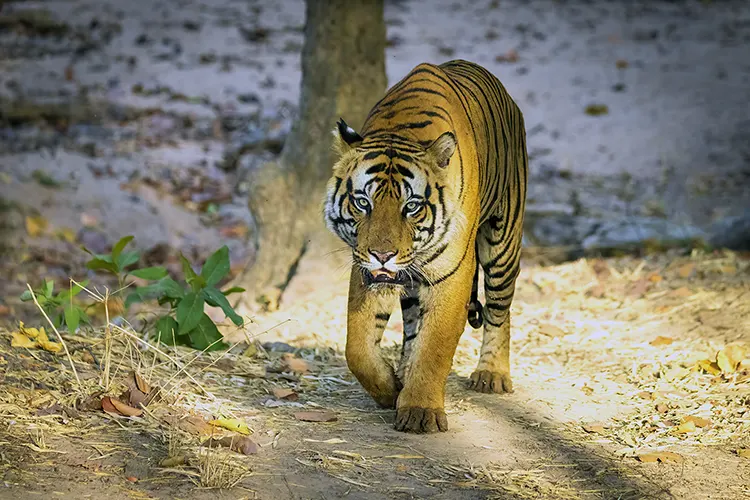Cookie
This website requires cookies to provide all of its features. For more information on what data is contained in the cookies, please see our Privacy Policy page. To accept cookies from this site, please click the Accept button below.
Now That You’ve Booked Your First Tiger Photography Tour, What Kind Of Camera Gear Do You Bring Along?
Simply put, the faster the better. Anything that will maximise the available light will help. I use my 600mm ƒ/4 and both the 300mm ƒ/2.8 and 70-200mm ƒ/2.8 stabilised lenses. In addition, I take a 16-35mm ƒ/2.8 and 50mm ƒ/1.4 for contextual images and habitat views.
You can never predict how far away you will be from a tiger, or how close! It could be 2m, it could be 50m. To give you an idea of perspective, the shots below were taken with the EF70-200 mm ƒ/2.8 at 70mm and the EF16-35 mm ƒ/2.8 at 35mm. If you don’t have a fast lens, I seriously recommend hiring one for your tiger safari.
The super-telephoto lens (300mm+) helps you peer through diffused vegetation or reach your subject at a greater distance. Sometimes, I have to use my 600mm at close range, just to get a headshot through the bamboo or other greenery. The telephoto’s narrow field of view can also help you crop out other unwanted distractions such as highlights on the forest floor or tourist vehicles in the background.
Although I often travel with my Gitzo tripod, the most practical support is the beanbag. You can buy them quite cheaply and take them to India empty. In the major parks like Ranthambhore, you can even buy them locally. On arrival at the national parks, you can ask the lodge/hotel to fill the beanbag with rice or beans. Beanbags are perfect for use in a jeep, thrown around quickly on to the seat backs and roll bars.
Another option is clamping your tripod head to the roll bars. Personally, I find this limiting. Another good option is the monopod. My latest acquisition is the Gitzo Carbon Monopod “Series 4” 6S. I needed something to support the 600mm while guiding in the small Gypsy Suzuki jeeps. If I’m guiding, I can’t just throw my beanbag wherever I want, so this gave me eye-level support from a fixed seated position. It worked a treat! The large base foot adds stability to the rig, with my gimbal bolted on top for manoeuvring my 600mm.
Tripods are awkward to set up in these small vehicles, unless you have the whole back to yourself. I certainly wouldn’t recommend them if you’re sharing.


You never know when or where a tiger might step out in front of you on a Tiger photography tour, so the motto is ‘Be Prepared!’ Avoid packing your camera away in a bag, no matter what the conditions. If a 10ft tiger crosses the 12ft track road you have about 4 seconds to take the shot. If you’re camera is zipped away in your backpack, switched off with the lens cap on… What chance do you have?
When you do encounter a tiger for the first time, you will need to concentrate like mad in order to calm your shakes and nerves. My advice: Take a deep breath, calm yourself, then take your shots. Do yourself a favour though and watch the tiger as well. Watch how the tiger moves and blinker out the other vehicles and humans.
I always have my camera in Aperture Priority mode unless I am shooting in dappled shade. AV mode gives me complete control over depth of focus and shutter speed. You just never know what is going to happen.
If a tiger has paused close by and there is the opportunity for a good portrait, then I close the aperture for a little more depth of field. But if the tiger suddenly starts running, I can quickly dial in an ƒ/2.8 or ƒ/4 for extra-fast shutter speed to freeze the motion, or a smaller aperture if I’m looking for a slower shutter speed and more blur.
Lighting
Lighting is a real issue. In five years I can remember just handful of situations where the tiger was in clear beautiful light. These situations are remarkably difficult to come by. Mostly, your view of a tiger will be in either very low light, high-contrast and dappled shade, or almost completely obscured by foliage. If the tiger hides behind by flora, is it worth taking a photo? Probably not, so just sit back and watch. I do. Just wait and hope it comes out.
Low-light Tigers
In very low-light, make sure you’re rock steady and try to wait for the tiger to stop moving. If you are in a jeep, they will often cut the engine when they stop. So rest the beanbag on the side of the jeep or on the roll bars. You can crank-up the ISO, open the aperture to the maximum, switch on your image stabiliser
Or you could try being more creative and go for ‘motion panning’. This uses a slow shutter speed – around 1/30th sec or less. The idea is to pan side-to-side with your upper body at the same speed and direction as the tiger. It sounds simple, but it is much harder to master than you might think. When it works, the results are brilliant. You may not hit it every time, but at least you tried to make the most of the situation.
Contrast & Dappled Shade
This is probably the most common situation and my method is quite straightforward. I take a test shot of the scene using spot metering and focus on an area of bright sunlit forest floor. The metering system automatically under-exposes to make the scene darker. I’ll alter the exposure so the highlights become mid-tone and the shadows almost black out.
When I’m happy, I enter these exposure details in ‘Manual Program’ mode. Now I can quite happily shoot away knowing that everything is of the same exposure, where the highlights are actually a mid-tone and the shadows are almost black. The trick now is to wait for the tiger’s face to appear in the sunlight. This produces images with far greater depth and atmosphere – just have a look at the image below and above.
Be mindful if the tiger moves, or the elephant changes location. Keep an eye on your histogram and review screen and adjust where necessary.
If you don’t have a Manual Program, then you will need to understand how to ‘manually compensate’ your exposure. This comes back to knowing your kit before you arrive. Your camera’s metering system will treat the scene as an average. If the shadow outweighs the highlights then they will be over exposed and ‘burnt out’. You will need to manually reduce the exposure to compensate.
These are just a few of my suggestions for your photographic journey during a Tiger photography tour but situations will always be different and its best to heed to your photographic leader for advice if you’re unsure what to. After all, that what they are there for!

